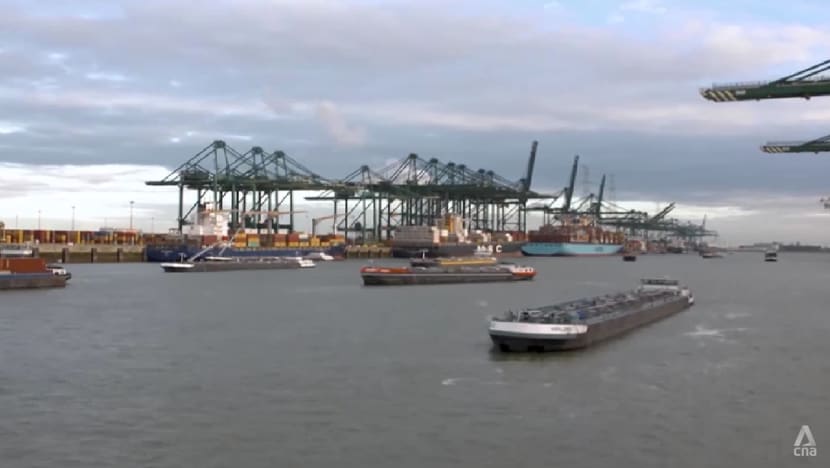Widespread deployment of large autonomous ships still a long-term prospect, say observers
These crew-less vessels operate independently without direct human control, using advanced sensors, navigation systems, and artificial intelligence.

Autonomous technology is transforming the movement of people and goods on the road, in the air, and increasingly, on the high seas.

This audio is generated by an AI tool.
SINGAPORE: Autonomous technology is transforming the movement of people and goods on the road, in the air, and increasingly, on the high seas.
The global market for autonomous ships grew more than 5 per cent last year, and is expected to expand as much as 30 per cent by 2028.
These crew-less vessels operate independently without direct human control, using advanced sensors, navigation systems, and artificial intelligence.
Observers said widespread deployment of large fully autonomous ships is still a long-term prospect, but investments in this sector will likely increase as regulations and standards become clearer.
This comes as about 90 per cent of the world's goods are transported by sea.
SAFER THAN CONVENTIONAL SHIPS?
The autonomous ships market is set to exceed US$10 billion in 2029, up from US$7.7 billion recorded last year, according to a global market report by The Business Research Company.
Asia Pacific dominates the industry, due to the region’s rapid advances in technology, significant investments and extensive maritime activities.
“(Asia) Pacific nations have a long history in ship building, and a significant proportion of the goods are traded within the Asia-Pacific nations and seas … this area tends to be able to accelerate on new technology adoption,” said Gianmatteo Barbieri, general manager of tech solutions provider C5S International at L3Harris Technologies.
“So it's natural that it is taking the lead in this autonomous transformation.”
Autonomous ships optimise travel routes, which results in navigational efficiencies and fuel savings.
Francis Zachariae, secretary-general of the International Organization for Marine Aids to Navigation (IALA), said human errors are largely to blame when ships collide or go aground, and digital solutions can help to reduce these incidents.
“I think autonomy can make shipping safer and more efficient,” he added.
“That's what they have succeeded with in aviation, that the pilot is very well assisted by these digital solutions. We are still not completely there in the maritime sector, and that's where I think autonomy could help.”
Industry experts told CNA that the shortage of qualified seafarers and savings on crew expenses have driven interest in autonomous solutions.
In Japan, for instance, ageing crew members have been a concern.
The average age of the seafarers there is between 60 to 65, said Neil Roberts, head of marine and aviation at Lloyd's Market Association.
“There is recognition in Japan at least, that there is a crew crisis in that you haven't got the people coming through. Therefore, one solution is to automate rather than train or source new crew,” he added.
ADOPTION OF UNMANNED SHIPS “WILL TAKE TIME”
The world's first fully electric container ship, MV Yara Birkeland, has been a pioneer in autonomous maritime transport since it started commercial operations in 2022.
It undertakes two voyages a week, transporting about 100 containers on each journey with only three crew members.
Plans are in the works for five voyages weekly with two crew members.
But the widespread deployment of large fully autonomous ships, such as container vessels and tankers, in international waters will take time, experts noted.
“It's far in the future,” said IALA’s Zachariae.
“In the foreseeable future, 20 to 25 years, you will have a mixed fleet. You will still have the normal ships with a normal crew on board, and more and more autonomous ships coming into the market.”
Newly constructed vessels will continue to operate for a couple of decades, and issues of reliability and communications also need to be managed, said experts.
“We are concerned about technology, whether it is safe enough ... We need to have perfect communication between autonomous ships and the control centre,” said Yuichi Sonoda, secretary general of the Asian Shipowners' Association.
“We are worried about cybersecurity issues, and we still don't know how we can use autonomous ships in the busy sea lanes like the Straits of Malacca and Singapore, and also busy ports all over the world.”
To balance innovation with safety, the international maritime community is building a set of standards so that the autonomous systems are compatible worldwide.
But observers noted that this is easier said than done.
“It's not easy to make these harmonised solutions, but it's really important, otherwise we'll not succeed,” said Zachariae.
He added that development in the area is largely driven by commercial companies, and not the authorities.
“They work from their own set-up in the country where they belong. And they do not always cooperate, and they might also want to protect their own solutions a little - so it's actually difficult to harmonise these digital solutions,” he said.















